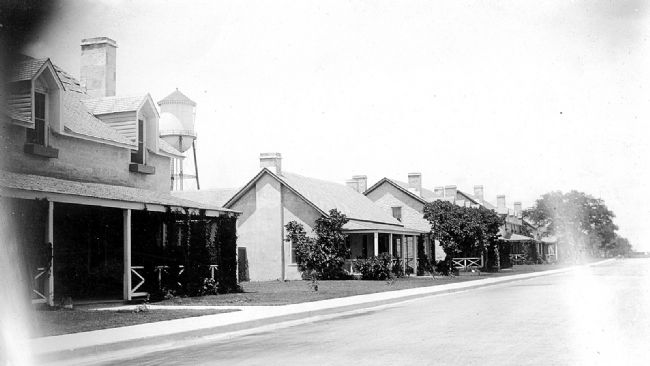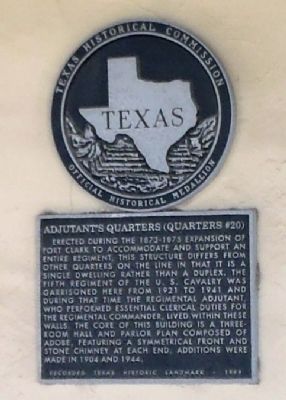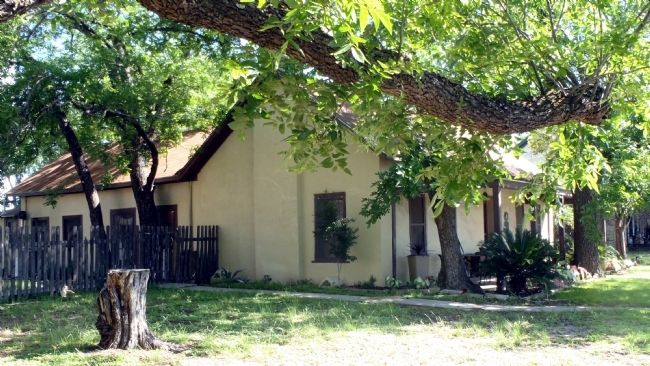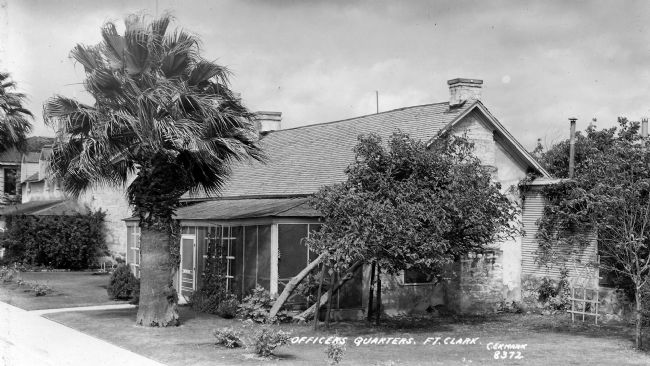Near Brackettville in Kinney County, Texas — The American South (West South Central)
Adjutant's Quarters (Quarters #20)
Erected 1999 by Texas Historical Commission. (Marker Number 12001.)
Topics. This historical marker is listed in this topic list: Notable Buildings. A significant historical year for this entry is 1921.
Location. 29° 18.302′ N, 100° 25.409′ W. Marker is near Brackettville, Texas, in Kinney County. Marker is on Colony Row, 0.1 miles south of Patton Drive, on the right when traveling south. Marker is located on Fort Clark Springs in the Fort Clark National Register Historic District and is accessible to the public. Touch for map. Marker is at or near this postal address: 20 Colony Row, Brackettville TX 78832, United States of America. Touch for directions.
Other nearby markers. At least 8 other markers are within walking distance of this marker. Staff Officers' Quarters (within shouting distance of this marker); U.S. Army Signal Corps Building (about 300 feet away, measured in a direct line); Commanding Officer's Quarters (about 400 feet away); Officers' Row Quarters (about 600 feet away); Married Officers' Quarters 8-9 (about 600 feet away); Remolino Raid (about 700 feet away); Officers Quarters 2-3 and 4 (about 800 feet away); 1873 Infantry Barracks (approx. 0.2 miles away). Touch for a list and map of all markers in Brackettville.
More about this marker. The subject of this marker is now a private residence.
Regarding Adjutant's Quarters (Quarters #20). To fill the vacant space between Quarters 18-19 and 21-22, a simple set of quarters (No. 20) was constructed of adobe, a readily available and inexpensive local material. The original floor plan was also simple, a single story with just three rooms and a fireplace on each end. This plan so closely mirrors the plan from the sets of Fort Clark's existing log officers' quarters constructed in 1854, that it may have been copied.
Occupancy of Quarters No. 20 in the nineteenth century was characterized by the distasteful practice, at least to officers' wives, of "turning out" another officer to secure quarters. A senior officer, even by brevet rank, could force an officer junior to himself to relinquish a set of quarters simply on demand. The junior moved out, the senior moved in and the junior then looked for someone he outranked so he could continue the process. The ladies referred to the ordeal as "falling bricks," as it could at times cause wholesale moves, affecting an entire garrison. The diary and letters of Lieutenant Francis H. French, 19th Infantry, stationed at Fort Clark 1882-1888, make regular commentary on the experience. "Eckerson and I had to move out of our quarters to another set in order to make room for Payne, who was turned out by Vedder, who was turned out by Weeks, who was turned out by Hall." Lieutenant French was a bachelor officer while at Fort Clark and was little impacted by the practice. However, for a married officer it was a source of considerable frustration and complaint.
After decades of grievances from Army wives and the advent of long term, often permanent stationing of units at the same post following the First World War, the practice of "turning out" faded away. In its place developed the custom of designating or reserving a set of quarters for the officer assigned to a particular duty position. Traditionally the only designated quarters on a post was the house built for the Commanding Officer, always the largest and best situated. Some posts

circa 1920s
3. Historic view of Fort Clark's Adjutanty's Quarters #20
In the foreground is Quarters No.21 with Quarters No.20 next in line. These quarters for company grade officers [Captains and Lieutenants] make up what was commonly referred to as “the line.” Note the window flower boxes, well manicured lawns, the light color paint [possibly the post color scheme recommended in 1928 of light gray, ivory cream and seal brown] and the decided absence of trees.
In the Fall of 1921 the Fifth United States Cavalry Regiment conducted a permanent change of station from Camp Marfa to Fort Clark. In the quiet time between the World Wars the Fifth Cavalry became indelibly associated with Fort Clark, garrisoning the post for a generation, until 1941. During the Fifth Cavalry era several sets of quarters were designated to be occupied by officers assigned specific duty positions. Quarters No. 24 was designated for the Colonel of the Regiment and No. 20, only three doors away, for the Regimental Adjutant. The arrival of the First Cavalry Brigade Headquarters in early 1922 forced the 5th Cavalry Commander (then Colonel William Dennison Forsyth) to relinquish the Commanding Officer's House to the Brigade Commander (a general officer) and move (an event remembered by the Colonel's daughter, Mrs., Elizabeth Forsyth Scheuber, then seven years old) into the second best set of quarters on the post, Quarters No. 24 (second best based on size, quality of construction, and being protected from the weather by Quarters No. 23). From that point until the regiment departed, Quarters No. 24 was designated for the Colonel of the Fifth Cavalry Regiment. (The most prominent resident was Colonel George S. Patton, Jr. from July to November 1938).
The Regimental Adjutant was an unattractive position normally filled by a senior lieutenant or a junior captain. The Adjutant for all practical purposes was a glorified clerk for the Regimental Commander. However, the Adjutant did perform the essential function of managing the endless flow of regimental paperwork and keeping the Colonel out of trouble in that department. It was and still is a thankless job involving long hours of tedious attention to detail. Quarters No. 20 was then a fairly obvious choice for the Adjutant's house. It was in close proximity to the Colonel's house and otherwise had no other status or desirability due to its size and style. In 1994 Mr. David R. Hollingsworth and his sister, Mrs. Virginia H. Cunningham visited Fort Clark to participate in the Fort's Elderhostel Program. It was a homecoming since their father was an officer in the Fifth Cavalry and they spent their childhood, in the 1930's, at Fort Clark. When their father was the Regimental Adjutant they lived in No. 20. When he was reassigned to command a Troop they moved into Quarters No. 19.
Quarters No. 20 maintains its architectural integrity while standing the test of time since 1874. Footsteps echo from the countless army families who made it their home. Throughout its existence the tiny adobe structure has retained its individuality and unique character nestled in among her larger more imposing two-story stone neighbors.
Credits. This page was last revised on August 27, 2020. It was originally submitted on May 16, 2012, by William F Haenn of Fort Clark (Brackettville), Texas. This page has been viewed 656 times since then and 29 times this year. Photos: 1, 2, 3, 4. submitted on May 16, 2012, by William F Haenn of Fort Clark (Brackettville), Texas. • Bernard Fisher was the editor who published this page.


